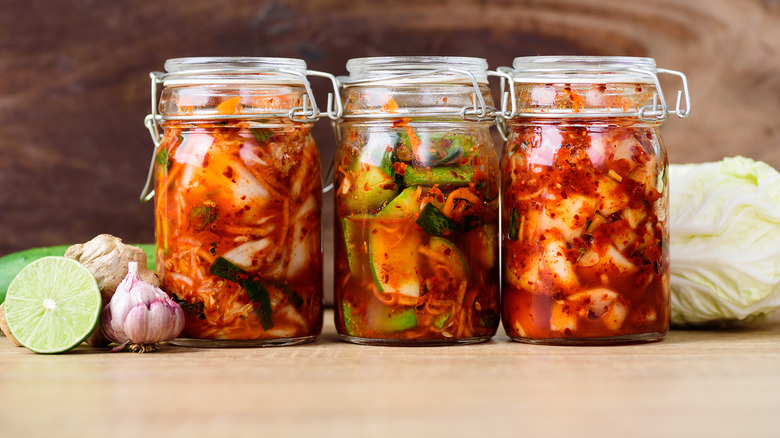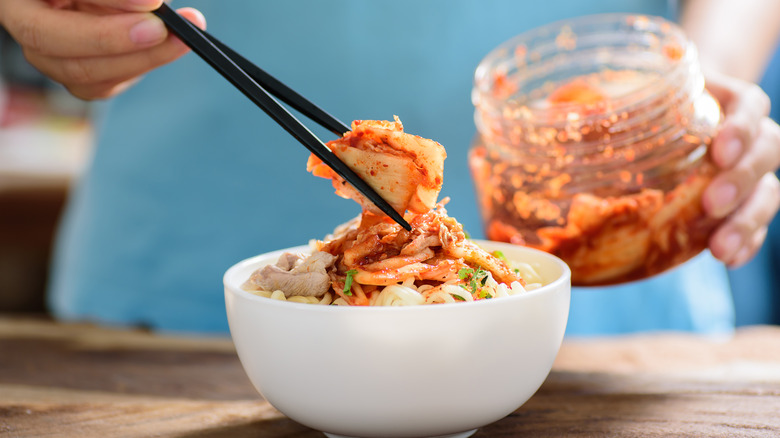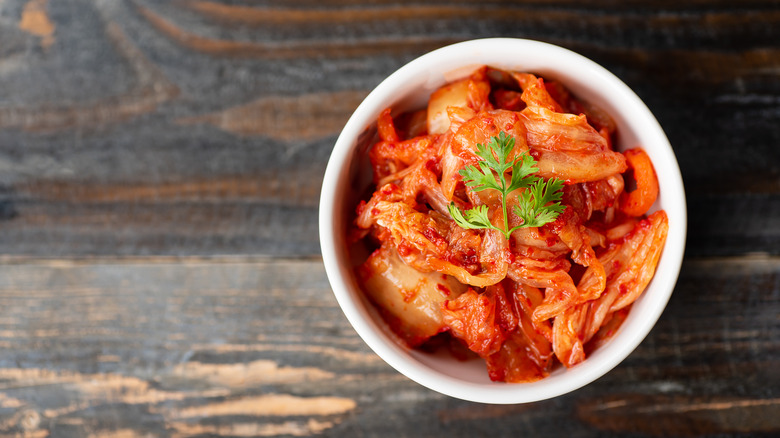How Long Does Kimchi Last In The Fridge?
Fermentation has been used as a method to preserve food for millennia. Take kimchi — not to be confused with sauerkraut – for example; it was invented to make fresh vegetables last through the harsh months of winter. So, it would only make sense for the fermented dish to have a fairly long shelf life, but how long is that exactly?
Well, kimchi's lifespan depends on several factors. It could stay fresh for anywhere between a couple of weeks to half a year in the refrigerator once opened or up to three months past the use-by date if it's unpasteurized and store-bought. However, kimchi's shelf life isn't always definitive, and it could last for much longer, especially if it contains salt or preservatives, which can extend its shelf life to three to four years in more extreme cases.
One thing to know about kimchi is that it carefully treads the thin line between fermentation and spoilage by inviting only select, harmless bacteria into the food. As it ferments at warm temperatures, these bacteria tenderize the vegetables, keep them from spoiling too quickly, and give the dish its tart flavor — a flavor that significantly deepens with time. This is why some prefer to let their homemade kimchi age for years to enjoy its wonderful complexity rather than eating it within a few months. However, the trick is to store it in a cool, controlled environment, as this will determine how long you can safely let your kimchi ferment before it starts to show signs of spoilage.
Storage tips to keep kimchi fresh for longer
Storage plays an important role in determining how quickly kimchi crosses the line of careful fermentation to spoilage. For instance, the dish only stays fresh for a week or so at room temperature, so it's always best to store it in the refrigerator. Even then, ensure that the temperature of your fridge is between 32 degrees Fahrenheit and 39 degrees Fahrenheit. This allows the dish to continue fermenting slowly without freezing or spoiling in the process.
Always store kimchi in an airtight jar and make sure that all the ingredients are fully submerged in the brine. Dry patches are more susceptible to turning moldy. Don't hesitate to use a spoon to push them down inside the liquid either, but make sure that the utensil is clean so that it doesn't contaminate the kimchi with harmful bacteria.
Another thing to be careful about is kimchi's exposure to air — it's a food storage mistake you need to stop making. Make sure that there is no air trapped inside the container before you seal it, and refrain from opening and closing it too frequently. This is why it helps to have a master jar of kimchi — a large vessel from which you spoon out smaller portions into a second container every few days. That way, you can open this secondary container whenever you need kimchi, but without compromising the entire batch in the master jar.
Signs that it's time to throw away the kimchi
Kimchi's shelf life isn't exactly definitive, so a better way to gauge its freshness is to watch for certain signs of spoilage. One of the most obvious indicators is mold. If you notice any black, white, or green fuzzy patches, it's time to throw the kimchi out. Eating any moldy kimchi can lead to food poisoning, but the consequences are even more serious if it contains seafood — take bossam kimchi, for example, which is made from salted shrimp as well as oysters and octopus on occasion. In some cases, seafood can lead to botulism, so it's best to be extra cautious with such varieties.
Rotten kimchi will also have a foul stench and an odd texture. Though the fermented side dish naturally has a tangy and pungent aroma that only gets stronger with time, it shouldn't smell rancid or putrid. However, be careful not to sniff it if you notice any mold, as breathing in the fungus can cause respiratory problems.
You will also notice kimchi's vibrant color becomes duller as it spoils, and its soft texture turns unpleasantly slimy. If all else seems fine, give the kimchi a careful taste. Old kimchi can taste sour and mushy, but that doesn't mean it has spoiled: You can always turn it into kimchi jjigae or this mildly insane kimchi bokkeumbap. However, it should never be unpleasant or eye-puckeringly sour to eat — that means it's time to toss the kimchi.



